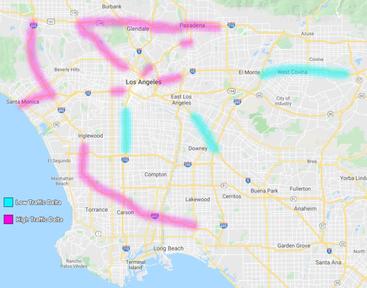Southern California region has among the worst congestion and air quality problems in the United States. The COVID-19 pandemic has caused a significant reduction in economic and social activities locally and consequent changes in roadway traffic. These changes are impacting mobility, air pollution levels, and the environment in a variety of ways. To date, preliminary data has shown that traffic is down approximately 45%. However, it is likely that traffic activity, and resulting impacts, are different in different locations. The COVID-19 crisis provides a real-world opportunity in Southern California to observe the changes in road traffic and develop correlations with various mitigation measures, observing effects at both the local and regional level.

It is important to go beyond just a regional analysis (e.g., all of Southern California) and analyze these effects at the local and transportation corridor level to assist in addressing equity issues, including environmental justice for disadvantaged communities. For example, port-related freight movement, a major economic engine for the region, results in disproportionate impacts to adjacent communities and major freight corridors. As California and the nation return to more normal activity rates and plan for the future, it is proposed to evaluate changes to traffic patterns and localized air quality to provide needed information regarding priorities for stimulus support, infrastructure investments, and other necessary actions to meet a broad array of policy objectives related to transportation, air quality, and climate change. Findings from this proposed study are expected to be applicable to other regions as well.

UCR CE-CERT was recently awarded funding from the University of California Institute of Transportation Studies to conduct an “Immediate-Need Data Collection Project” related to the COVID-19 crisis and transportation in the state of California. A group of CE-CERT researchers, led by Dr. Shams Tanvir is developing integrated analytical framework to determine changes in CEselect local, corridor, and regional traffic due to COVID-19 mitigation measures. Followed by an analysis of the relationship of traffic-related changes to critical air pollutant concentrations. In addition, changes to mobile source-related indicators used to rank environmental justice communities for policy and funding purposes will be evaluated.
In summary, the integrated analysis framework can be used to understand the effect of different restrictive and recovery activities across the timeline of the COVID-19 pandemic on mobility, localized pollutant exposure and corresponding environmental equity. Understanding such relationships will be important in creating and evaluating existing and potential new policies in response to any future such communicable disease outbreak. The results will also provide valuable information that can be used to improve currently required regional and sub-regional transportation, land use and air quality plans. Thus, providing public health, mobility, economic, equity, climate, and sustainability benefits.